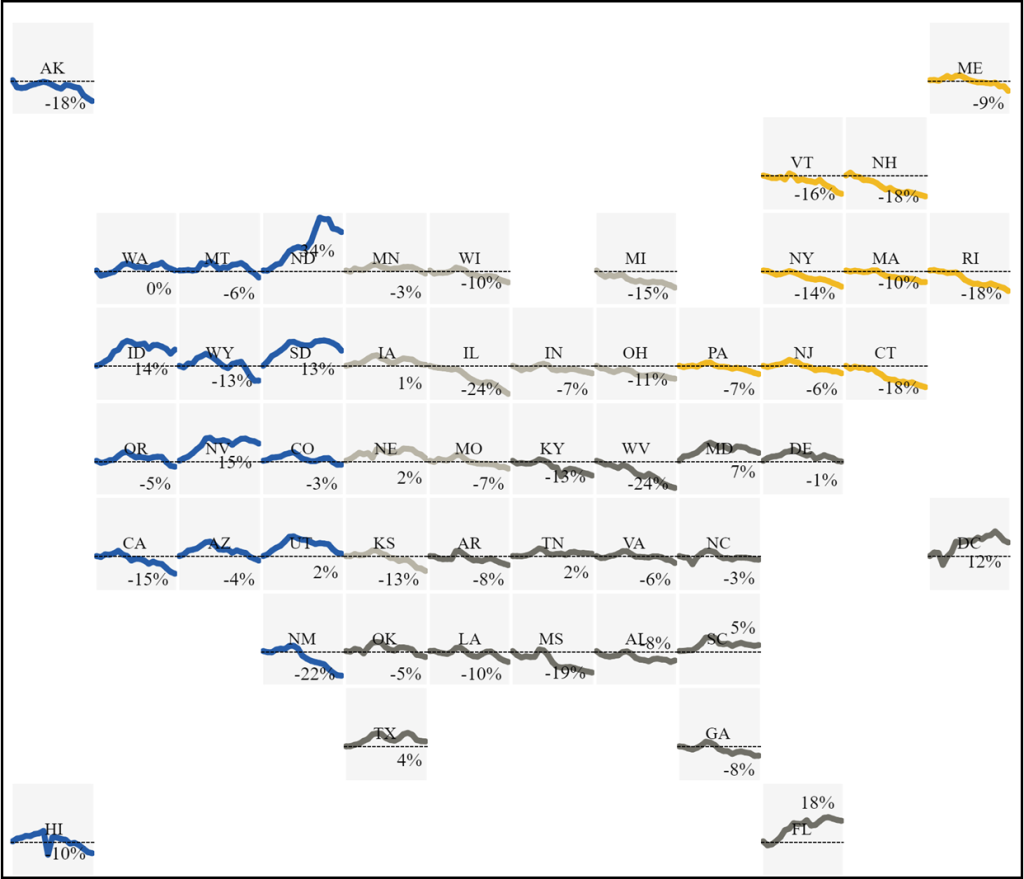Accountability for Higher Education Means Creating a Vital Economic Future for America
Published by: WCET | 1/19/2023
Tags: Distance Education, Higher Education Trends, Online Learning, Student Success, Workforce/Employment
Published by: WCET | 1/19/2023
Tags: Distance Education, Higher Education Trends, Online Learning, Student Success, Workforce/Employment
Does anyone else feel like we are constantly on a precipice – waiting for the next “big thing” to tip us over? I do feel that way often, whether I’m thinking about my professional life, technological advances, or an innovative VR art exhibit I really want to check out.
Higher Ed is having one of those moments. And its not quite as intriguing as ChatGPT or visiting a museum by wearing a VR headset, but important nonetheless. Our tipping point however, is due to changes in our economy, population, and workforce needs.
Today we welcome Kara Monroe, longtime colleague and friend of WCET and President and Founder, Monarch Strategies, to discuss current higher ed enrollment predictions and the demands from employers that we must answer. It’s higher ed’s time to shine (and hopefully not tip over the edge).
Kara will be writing another post this month as well as several resources for WCET members. Stay tuned!
Enjoy the read,
Lindsey Downs, WCET
A few days ago, I watched the Netflix documentary about music producer David Foster. In describing his childhood, Foster said, “We had no money but we weren’t poor.” Foster grew up in a two parent household where dad worked and mom stayed home to raise seven children. That line struck me – it feels so impossible to achieve a semblance of that life in today’s world. Today, being poor seems so much harder to overcome than it did in the 1950s when Foster came of age.

My parents were able to put together a really great life for me and my three siblings. We had a little money but at times I considered us poor – particularly in comparison to some of my peers. Neither of my parents had a college education.
My dad tried at college and failed. My mom, who would likely have been the first of us to earn a doctorate had the opportunity been available to her, was kept out of the higher education arena by time, circumstances, and some of her own decisions.
But, today, poverty is, particularly for children, in some places as high as it was when Foster was coming of age. The poverty rate in 1950 was 22% – the highest on record. Today, at its surface, the poverty rate in the US is much lower – about 11.6%. However, when you drill into it you realize that the variation tells the real story. Child poverty tops 22% in many places and poverty levels vary by state for all age groups.
What is also interesting to consider as we think about the poverty rate is that the percentage may have changed, but as the American population has decreased dramatically over the last few decades, the actual number of people living in poverty has not changed. This is an interesting highlight of the wealth gap in America, and higher education must help to address this by providing individuals with the skills to overcome poverty.
Additionally, the American population is aging. Far fewer young people are projected to be born – leading to an enrollment cliff for higher education institutions in the U.S..
WICHE’s excellent report, Knocking at the College Door, is an outstanding analysis of these and other trends impacting higher education’s enrollment.
I urge you, if you have not yet, to go to the Knocking Report and explore your own state’s data in depth. As a nation though, what the report projects is a decline in enrollment.

This gives us a blunt picture of the future of the supply and demand in American higher education – but what of the supply chain we serve – that of employees for the American workforce. Employers are demanding more talented labor now – and will continue to do so into the future with an anticipated 8.3 million jobs being created by 2031.
This means, we in higher education must change – and we must do so quickly. Embracing new manufacturing technologies, new computing skills, and making changes in the ways that we educate individuals to better meet their needs and the needs of the employers we serve.
I recently evaluated grants for a nonprofit organization. The grants were for expansion and/or improvement of nursing programs at mostly community colleges across the country. The grantor was looking for “innovative” programs. To my great disappointment, the most innovative thing that any institution really presented in that grant program were part-time programs and evening/weekend programs.
Part-time and evening/weekend programs in nursing or other areas are certainly challenging; they are far from innovative.
We must move beyond saying something is hard or impossible. Instead, higher ed should begin by breaking down the challenge into individual parts. Next, we can figure out creative ways to overcome those smaller challenges. Part-time and evening/weekend programs demand more of faculty and of our institutional partners and of institutional support services – and we must meet those demands.
Our example from above provides the framework for the next thing that higher education must do if we’re going to keep pace with the changes in the economy:we must do what students need us to do rather than what we want to do.
Part of why part-time and evening/weekend programs are necessary is that students need to be able to work, care for their families, and go to school all at the same time. We must make education fit into the lives of students.
A friend from California visited over the holidays. She explained that their enrollment at her college was up to pre-COVID levels when they left online classes on their schedule. But, according to her, in California online classes are reimbursed by the state at a lower rate than traditional classes and so administrators pulled online classes off the schedule to put on more traditional classes. They built it. But students didn’t come.
This leads to our third point of what we must do.
From accrediting agencies to state and federal governments, we in higher education must redouble our efforts to improve the quality of education while also improving its reach. Brookings told us in 2017 that access was no longer the problem – but completion was. I disagreed with that finding then and I disagree even more with it now. Both quality and access are problems of equal degrees and they must be worked on in tandem.

In higher education we often feel like we’re being held accountable by everyone and yet no one is accountable to us, except perhaps our students. However, in real accountability systems there are feedback loops that help to measure the quality of the accountability. Where these don’t exist today we must advocate for their inclusion and leave organizations that are no longer serving us or our students.
From accrediting organizations that say they will refuse to accredit programs with any fully online classes to legislators that believe it is in our best interest to go through the arduous and expensive process of changing accreditors every decade or so, we must provide accountability in new and better ways. Engage employer partners who indicate they won’t hire your graduates unless they have a specific accreditation and provide them data on how students do in follow up classes, even after taking a preceding class online. And, clean up your own house. If You find data that shows a lack of accountability on your part, do the work to redesign and improve that course. Help those employer partners leverage the accreditor on your behalf. And, no matter what you do, vote. Educate your students and encourage them to make educated voting decisions.
This was a broad look at what higher education needs to do in order to meet the demands of a growing and changing economy. Especially as more higher education enrollment comes from new and different sources, rather than the traditional high school population that has long been our lifeblood.
In the next blog post, I’m going to provide a more specific approach to partnership with businesses and industry to give you a framework for how this could happen at any institution. And, we’ll follow this up in this month’s Closer Conversation for WCET members as well as have a detailed guide in MIX for WCET Members. I’d love to know where you’ve tried and succeeded and where you’ve tried and failed in the comments or on Twitter at @KNMTweets.
President and Founder, Monarch Strategies LLC